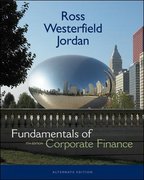Answered step by step
Verified Expert Solution
Question
1 Approved Answer
Theses are extended response questions so no need to show math. Thank you. a. You work for a firm that is very good at sheltering

Theses are extended response questions so no need to show math. Thank you.
a. You work for a firm that is very good at sheltering income from corporate taxes. As a result, your firm as a fairly low effective corporate tax rate of 10 percent. The debt holders of your firm face a marginal tax rate on interest income (from debt payments) of 20 percent. Your shareholders face a tax rate on capital gains and distributions to equity of 10 percent. In the event of a bankruptcy, your bankruptcy costs will be about 5 percent of the value of the assets that remain. Should you have a lot, a little, or no debt in your capital structure? Explain why. b. When (i.e., under what conditions) might managers, working on behalf of shareholders, take on risky but negative NPV projects? c. The tax bill passed by the US Congress a few years ago lowered corporate tax rate on us firms to 20%. The tax bill also did very little to close a number of loop-holes firms use to reduce their taxes. Based on this reduction in the effective tax rates US firms pay, what does static trade-off imply with respect to changes, relative to pre-tax-bill levels, in (a) the optimal amount of debt firms will have in their capital structure, (b) the values of firms (if nothing else other than the tax rate changes), and (c) the likelihood of future bankruptcies. Why? a. You work for a firm that is very good at sheltering income from corporate taxes. As a result, your firm as a fairly low effective corporate tax rate of 10 percent. The debt holders of your firm face a marginal tax rate on interest income (from debt payments) of 20 percent. Your shareholders face a tax rate on capital gains and distributions to equity of 10 percent. In the event of a bankruptcy, your bankruptcy costs will be about 5 percent of the value of the assets that remain. Should you have a lot, a little, or no debt in your capital structure? Explain why. b. When (i.e., under what conditions) might managers, working on behalf of shareholders, take on risky but negative NPV projects? c. The tax bill passed by the US Congress a few years ago lowered corporate tax rate on us firms to 20%. The tax bill also did very little to close a number of loop-holes firms use to reduce their taxes. Based on this reduction in the effective tax rates US firms pay, what does static trade-off imply with respect to changes, relative to pre-tax-bill levels, in (a) the optimal amount of debt firms will have in their capital structure, (b) the values of firms (if nothing else other than the tax rate changes), and (c) the likelihood of future bankruptcies. WhyStep by Step Solution
There are 3 Steps involved in it
Step: 1

Get Instant Access to Expert-Tailored Solutions
See step-by-step solutions with expert insights and AI powered tools for academic success
Step: 2

Step: 3

Ace Your Homework with AI
Get the answers you need in no time with our AI-driven, step-by-step assistance
Get Started


